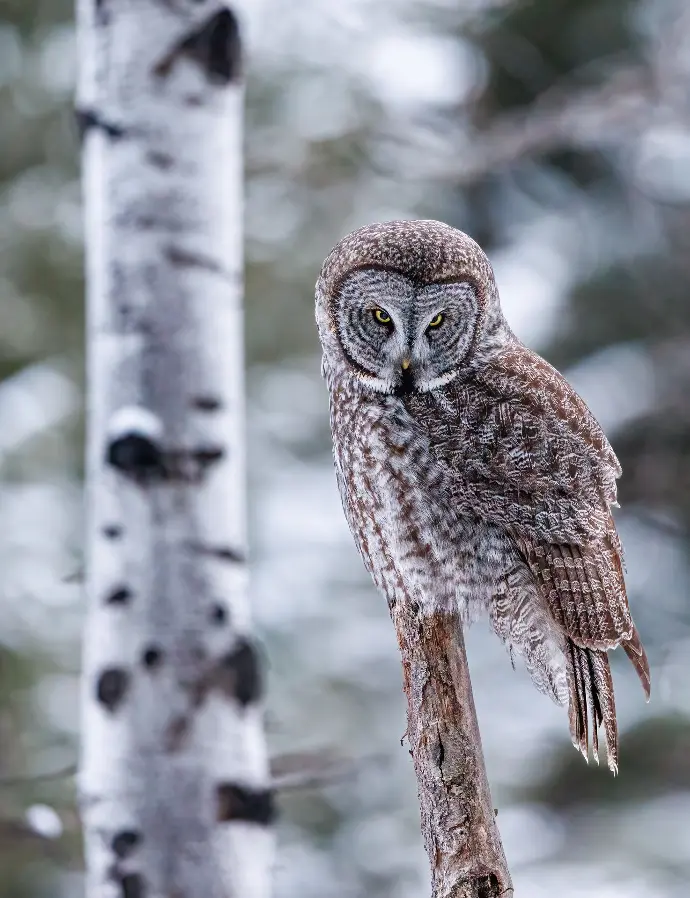
Example Projects: Owl Sense in the Wild
Great Gray Owl Research in Montana - Owl Research Institute
One of the exciting projects for which Owl Sense was created, focuses on studying the Great Gray Owl, a majestic species known for its distinctive appearance and elusive behavior. This research aims to understand their territories, vocalizations, nesting patterns, and habitat preferences using Owl Sense bioacoustics recorders.
Project Overview
- Deployment of Owl Sense Autonomous Recording Units (ARUs): Starting in March, during the late winter when Great Gray Owls are particularly vocal, we deploy 50 Owl Sense ARUs in suitable habitats. This timing is crucial as it aligns with their breeding behavior, providing an opportunity to capture a wealth of vocalizations.
- Systematic Monitoring: We strategically move the recording units every week or two to cover more extensive areas of potential habitat. This approach allows us to gather a comprehensive dataset, increasing the likelihood of detecting owl vocalizations across different locations. This allows us to cover hundreds of distinct locations.
- Audio Analysis: Once recordings are collected, we analyze the audio using BirdNET and custom models developed within the Opensoundscape platform. This analysis focuses on detecting and identifying various vocalizations of the Great Gray Owl, which are vital for understanding their territories and communications.
- Nest Site Identification: The detected vocalizations help us determine areas where owls are active, guiding our efforts to locate potential nest sites. By focusing our fieldwork in these key areas, we increase the chances of finding active nest sites.
- Behavior and Habitat Study: Once nest sites are identified, we conduct detailed observations to study the behaviors of the Great Gray Owls and assess the habitat characteristics that support their nesting and habitat needs. This information is crucial for informing conservation strategies and habitat management practices.
Through this project, we aim to contribute valuable data to the understanding of Great Gray Owl ecology and promote effective conservation efforts for this remarkable species.
Surprise Canyon Bird Surveys in Western Death Valley – The Institute for Bird Populations
IBP chose to use Owl Sense units to survey for a broad set of bird species in Surprise Canyon because of their small form factor and weight, long runtime, economical price tag, rugged design, and ease of use. The aim of this project was to document the bird species using this unique stream reach to inform management planning at Death Valley National Park.
Project Overview
-
Autonomous Recording Unit (ARU) deployment: 50 units were backpacked in 5 miles and deployed beginning in April along three portions of greater Surprise Canyon. This early deployment captures the arrival of migratory species and the initiation of breeding. Cards and batteries were changed 2 more times during the season, and then units retrieved in late October.
-
Point counts: In-person bird surveys were done alongside the ARUs during the deployment and card changeout periods to compliment the data being collected by the units.
-
The breadth of this ARU deployment provides information on both arrival, breeding, and departure of bird species. Because these units have long runtimes, visits to the field site could be relatively infrequent.
-
Audio Analysis: Automated classifier tools like BirdNET and Perch allow us to quickly identify the entire suite of species that may be present within the canyon, including four species of special interest: American Dipper, Willow Flycatcher, Bell’s Vireo, and Inyo California Towhee.
-
Diversity Hotspots and Phenology: Using the classifier results we can map hotspots of bird species along the canyon and track trends in species richness through the season. Additionally, trends in the relative number of vocalizations per species through time may inform our knowledge of timing of breeding and/or migration.
By using acoustic monitoring in this project, we are much more likely to detect rare species that might be missed during only a handful of in-person surveys. We have already detected one of the focal species because of the acoustic monitors and was not detected during in-person surveys. Regions such a Surprise Canyon, an area that provides flowing water year-round in Death Valley, may be increasingly important to birds and other wildlife as the climate warms. Through acoustic monitoring we can catalog the species using this unique area.